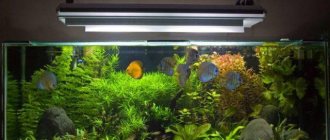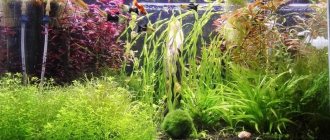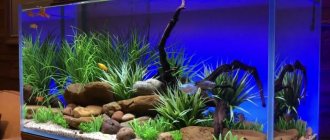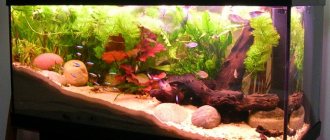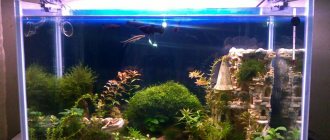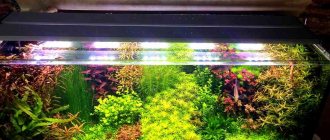All life on earth and even aquatic inhabitants need light. The ability to live of all residents of aquariums - fish, gastropods, crustaceans and crustaceans - depends on it. Aquarium plants also need lighting. If they have enough light, their lives become active and all animals feel great. This material is devoted to the problem of choosing aquarium lamps: we will tell you why they are needed, and which aquarium lamps are among the 8 best.
- What are aquarium lamps for?
- What to consider when choosing aquarium lamps
- Calculations when choosing a lamp
- Top 8 Best Aquarium Lamps
- The most popular question about aquarium lamps
How to choose a lamp for an aquarium
Type.
Metal halide lamps are considered the best and most professional: they lead in all respects, have a long service life and are able to illuminate even deep aquariums well. The only drawback of this type is that it gets very hot, which means they need to be suspended at least 30cm above the water's edge. Average aquariums usually use fluorescent or LED lamps. Both types have acceptable characteristics and can be selected according to the individual needs of the buyer.
Lamp power is measured in watts.
There is no general formula by which it would be possible to calculate the appropriate power for any aquarium: it is necessary to take into account both the parameters of the tank itself and the quality of the water, the number and type of plants. For most underwater flora, the optimal indicator will be 0.5-0.8 W per liter of water. When the aquarium is densely populated with plants, the power should be increased, but shade-loving species will be happy at 0.2-0.4 W/l. It must be taken into account that different types of lamps can produce different amounts of light even at the same power.
The spectrum affects the quality of photosynthesis.
Shade-loving plants prefer the blue-violet part of it, light-loving plants will benefit more from the red part. For favorable illumination of fish, a lamp with a green part of the spectrum is best suited.
Color temperature indicates how light will be perceived by the human eye.
A temperature of 5500 Kelvin is “white”, natural and familiar sunlight. However, for an aquarium, the optimal value is 7000-8000 Kelvin: at lower temperatures, underwater inhabitants look pale and sick, at higher temperatures they seem artificial.
Top 3. Tetra, Tetronic LED ProLine 980
Rating (2021): 4.25
- Characteristics
Average price: 13,800 rub.
- Country: Germany (produced in Poland)
- Color temperature: 6000K
- Luminous flux: 1868 lm
- Maximum power: 28 W
This LED lamp is popular due to its balanced emission spectrum required by underwater vegetation. An additional advantage is that it is protected from moisture and dust. The lamp can be lowered for a few minutes into water at a meter depth, and it will continue to work normally. That is, if it accidentally falls into the water, nothing bad will happen. Lamps with T5 and T8 sockets are suitable for replacement. Conveniently, there are several ways to install the lamp. Can be installed on top, on the two side edges of the glass if its thickness does not exceed 10 mm, or directly on the aquarium lid using self-tapping screws.
Advantages and disadvantages
- Long LED lifespan, up to 50,000 hours
- Dustproof and completely waterproof
- Balanced emission spectrum, ideal for plants
- Economy night mode, soft blue glow
- High cost, more than 13,000 rubles
- Few reviews from users, quality cannot be assessed
Best Lamps for Saltwater Aquariums
Representatives of this category stand out for their power, allowing the light flux to pass to the very bottom without scattering. It is recommended to use them in deep, large containers. Sometimes these lamps have a function that imitates the light of the moon, which is important for the growth of coral reefs and the spawning of certain species of marine life.
JBL Solar Ultra Marine Day
The white, coolish light of the lamp is ideal for a home pseudo-sea. This glow has a very beneficial effect on the growth of corals. The device has a high level of light output, so you don't have to worry about insufficient lighting at the bottom of the tank. The manufacturer guarantees 8000-10000 hours of uninterrupted operation of the lamp under favorable conditions.
Pros:
- Promotes the development of invertebrates;
- Easy to find on sale;
- Long service life;
- Low power consumption.
Minuses:
- Overpriced.
This lamp is ideal for a reef pond. To obtain excellent illumination and fluorescent results, it is recommended to combine it with Solar Ultra Marin Blue from the same manufacturer.
Hailea Extra Reef T5
The model with a dominance of the blue-violet spectrum is suitable for the inhabitants of a marine aquarium, as it creates an imitation of the illumination of a coral reef at a depth of six meters. This light promotes the growth of unicellular organisms and corals.
Pros:
- Promotes coral growth;
- Excellent quality;
- Aesthetic appearance;
- Reasonable price.
Minuses:
- Rarely found in our stores.
Illumination with such a lamp will make your aquarium a copy of the seabed. Corals, sea fish and cichlids feel great in its light.
Hagen Marine Glo T8
A fluorescent lamp from a Canadian manufacturer produces a limited-spectrum blue glow, ideal for saltwater aquariums. Such lighting will create the appearance of the seabed in the aquarium. In addition to its decoration function, the lamp has a beneficial effect on the growth of corals and invertebrates, and stimulates plant photosynthesis.
Pros:
- Does not increase water temperature;
- Many power options (from 15 to 40 W);
- Suitable for aquariums of different sizes (length 45-120 cm);
- Durable.
Minuses:
- Over time, it loses its “useful” properties.
Marine Glo is suitable for home ponds with reef-dwelling invertebrates. Its light has a good effect on their fluorescent pigments. It is recommended to combine it with Life-Glo or Power-Glo lamps.
Top 1. Aquael, LEDDY SMART LED II SUNNY 6W
Rating (2021): 4.40
Nice design, modern look This lamp will not only not interfere with the design of the aquarium, it will even decorate it. The compact model has a nice modern design.
- Characteristics
Average price: 2385 rub.
- Country: Poland
- Color temperature: 6500 K
- Luminous flux: 600 lm
- Maximum power: 6 W
Nano-aquariums are small containers with a volume of no more than 40 liters. The lamp from Aquael has proven itself to have excellent characteristics - it can be called the best in its price range. Users note the ease of installation - thanks to the well-thought-out design, it is easily fixed to the edge of the wall if the glass thickness does not exceed 6 mm. The LEDs are quite powerful (6W), color temperature is about 6500K. This is a good indicator for creating favorable conditions for the growth of ornamental aquatic plants. The lighting is natural and looks attractive. The lamp can be used in shrimp farms. According to the manufacturer, it works without replacement for up to 50,000 hours.
Advantages and disadvantages
- Decent appearance, looks modern and neat
- Underwater vegetation responds well to lighting
- Convenient fastening, simply fixed on the glass
- Natural light, looks attractive
- Affordable price, just over 2000 rubles
- Not the most reliable design, the mount sometimes breaks
- Brightness is only enough for a small aquarium
See also:
- 10 best aquarium lights from AliExpress
to the beginning of the rating
The best phytolamps for growing aquarium plants
Models from this category create the best conditions for photosynthesis and growth of aquarium plants. The lamps do not heat the water, do not burn the leaves and do not harm the fauna living nearby.
Dennerle Trocal Special Plant
Dennerle lamps are manufactured using the new Longlife-Technik automated technology, which provides them with more than 10,000 hours of operation. The UV-stop coating film prevents the formation of algae directly on the lamp.
The spectrum gives a glow close to that of the sun and promotes rapid growth of plants (even very fastidious ones). High color rendering ensures that the fish are illuminated in the most advantageous shades.
Pros:
- Suitable for all aquarium lights;
- Very long working life;
- The UV-stop film also protects against flying fragments when dropped;
- Economical.
Minuses:
- Expensive.
To create a unique planted aquarium with proper vegetation, equip your pond with such a lamp. It will also help control algae growth.
Osram T8 Fluora
The fluorescent model has proven itself well not only among aquarists, but also among those who like to grow indoor plants. Still, such a lamp is more appropriate for home ponds: its glow, with an emphasis on the red and blue spectral regions, activates the growth of flora and interestingly highlights aquatic inhabitants.
Pros:
- Does not heat water during operation;
- Many variations in power and size;
- Consumes energy economically;
- Affordable price.
Minuses:
- Over time, it loses its “special” properties.
If the plants in your herbalist have become dull and have stopped growing, pamper them with the glow of an Osram Fluora lamp - they will definitely thank you with lush growth.
Sylvania FHO T5 Aquastar
The spectrum of a fluorescent lamp from a German brand with a high proportion of blue and red radiation is as close as possible to tropical sunlight. This model can be used for both freshwater and marine aquariums. It stimulates the lush growth of plants and corals, highlighting the natural color of fish.
Pros:
- Excellent light output;
- Provides excellent flora growth and protection from algae;
- Lots of power options.
Minuses:
- Light output decreases after 12 months of use due to natural aging.
With such lighting, a tropical aquarium will sparkle with new colors. And the glow of the lamp will not harm either flora or fauna.
How much light do you need
So, how do you understand how much light you need? The first thing to think about is what plants and how many you plan to grow. Different plants need different amounts of light. For normal photosynthesis, illumination from 1000 to 10,000 lux below the surface of the water is required. A large excess of these values will not have a very favorable effect on plant growth. A slight excess will make the color of the plants a little brighter. It should be understood that the more light, the more carbon dioxide and nutrients plants need. And if you cannot provide the plants with this, then they will simply begin to die and your beautiful aquarium will become overgrown with algae. It's worth focusing on 3000-4000 lux, or less. For the average aquarium, and not very light-loving plants, this is more than enough. Do not forget about the depth at which plants grow. For example, if these are narrow-leaved cryptocorynes, then 400 lux or less is enough for them. I made a separate page with the light requirements of different plants.
The Best Full Spectrum Lamps for an Aquarium
Representatives of this group emit natural white light, which is similar to natural daylight. Thanks to it, the aquarium plants receive the necessary conditions for development and growth, and the color of the fish becomes incredibly bright.
Sylvania Aqua-Classic T5
The fluorescent lamp of the German brand Sylvania is manufactured according to new standards using tri-phosphor technology and combines two functions at once. The balanced ratio of blue-red radiation promotes photosynthesis, and at the same time favorably illuminates all inhabitants of flora and fauna. With such a lamp your aquarium will take on a fabulous look.
Pros:
- Suitable for aquariums of different types and shapes;
- The spectrum corresponds to natural sunlight;
- Perfectly illuminates both plants and fish;
- Excellent quality (made in Germany).
Minuses:
- High price.
The lamp is designed for beginner aquarists. Its radiation will ensure the proper development of plants and will perfectly highlight the natural color of the fish.
JBL Solar Ultra Natur LT T5
The unusually bright lamp can be used in tropical tanks, both with sea and fresh water. Excellent color rendering will provide bright and at the same time natural shades of all the inhabitants of the aquarium. Some components of the spectrum do not decrease to “0” and form a flux of light from sky blue to ruby.
Pros:
- Very bright glow;
- Ideal for tropical flora and fauna;
- Easy to find on sale.
Minuses:
- Expensive.
This versatile and very powerful device is suitable for any indoor pond.
Hagen Sun Glo
The glow emanating from this lamp is very soft, similar to daylight. Perfect for a fresh water aquarium with unassuming inhabitants with rich natural colors. For more demanding fish and plants, you will need to select an auxiliary light source.
Pros:
- Simulates daylight well;
- Slows down algae growth;
- Easy to find in stores;
- Budget cost.
Minuses:
- The color temperature is lower than that of daylight.
A lamp of medium brightness and a warm glow will create the most natural lighting for aquarium vegetation, and will also advantageously highlight the color of the fish. The manufacturer recommends combining it with the Aqua-Glo and Life-Glo models.
Frequently asked questions from users
How to choose the right lamps for an aquarium?
If there are no plants in the aquarium, then you can play with the spectrum. And so select 0.5 W per 1 liter. In general, a 30 W lamp is enough for a 100-liter aquarium.
An aquarium lamp is a necessary lighting device for improving photosynthesis of plants and for emphasizing the color of fish and grass. The review included the best fluorescent, LED, and metal halide models. When choosing, you should pay attention to the luminous flux, glow temperature, power and length of the lamp.
General lighting rules
Aquarium plants need light more than fish. Flora requires light for the process of photosynthesis, without which their development and growth is impossible. As for fauna, light is required mainly to form a daily regime.
Another point why it is important to create light correctly is observing pets and creating original light decor.
Based on this, basic requirements have been formed regarding the use of lighting for aquariums, including:
It is imperative to cover the lamp with a protective cover to prevent water from entering it. In some cases, a glass lid is needed. The light should be evenly distributed evenly. The lighting power should be selected correctly based on the number and quality of inhabitants. The light source should produce both a blue-violet and an orange-red spectrum
Top 2. Jebo UV-H24
Rating (2021): 4.55
The fastest action According to user reviews, this sterilizer works really quickly. Within a day, the blooming water becomes more transparent.
- Characteristics
Average price: 5350 rub.
- Country: China
- Sterilizer type: external
- Aquarium volume: 550-1365 l
- Power: 24 W
Universal device for all types of aquariums. But when purchasing a lamp, you need to take into account that for a marine aquarium it should be approximately twice as powerful as for a freshwater one. Among the advantages, users note fast action. According to reviews, with slight turbidity, the water is cleared within a day after the start of use. Long service life. Buying a replacement ultraviolet lamp will not be a problem - it costs about 800 rubles.
Advantages and disadvantages
- Reasonable price with high power of the device
- Inexpensive replacement lamps, about 800 rubles
- Fast action, water is purified within 24 hours
- All necessary fastenings are included in the kit
- Large size, requires space
- Not the best quality plastic
See also:
- 8 Best Aquarium Heaters
Daylight hours and control options
Due to the fact that the aquarium lighting must turn on and off at certain intervals, it is not entirely convenient to carry out such a procedure using a classic switch. As a rule, the lighting duration is 12 hours, and such periodic switching can be done automatically using a timer or time relay.
A timer for setting the duration of lighting is the simplest and most understandable control device for the average person. There are models already adapted for an aquarium, so they only need to be installed and adjusted to the desired time of supplying and turning off the voltage. Their advantage is that configuration occurs in real time.
Rice. 9. Connecting aquarium lighting via a timer
Relays, unlike timers, are not capable of controlling processes in real time. You can only set the frequency of a particular logical operation, for example, that the voltage will be supplied after 12 hours, and after another 12 it will turn off again. The advantage of a relay is only if there is a mechanism with a power reserve that will not break down in the event of fluctuations or when the voltage is turned off; you can also install a sensor with it.
Rice. 10. example of connecting lighting via a relay and sensor
Depending on the installation method, control devices can be placed on an outlet or in a distribution panel. The first option is much cheaper and can be easily used in already installed aquariums. The second is more labor-intensive and is usually implemented at the stage of laying the wiring, but it eliminates unnecessary connecting wires.
